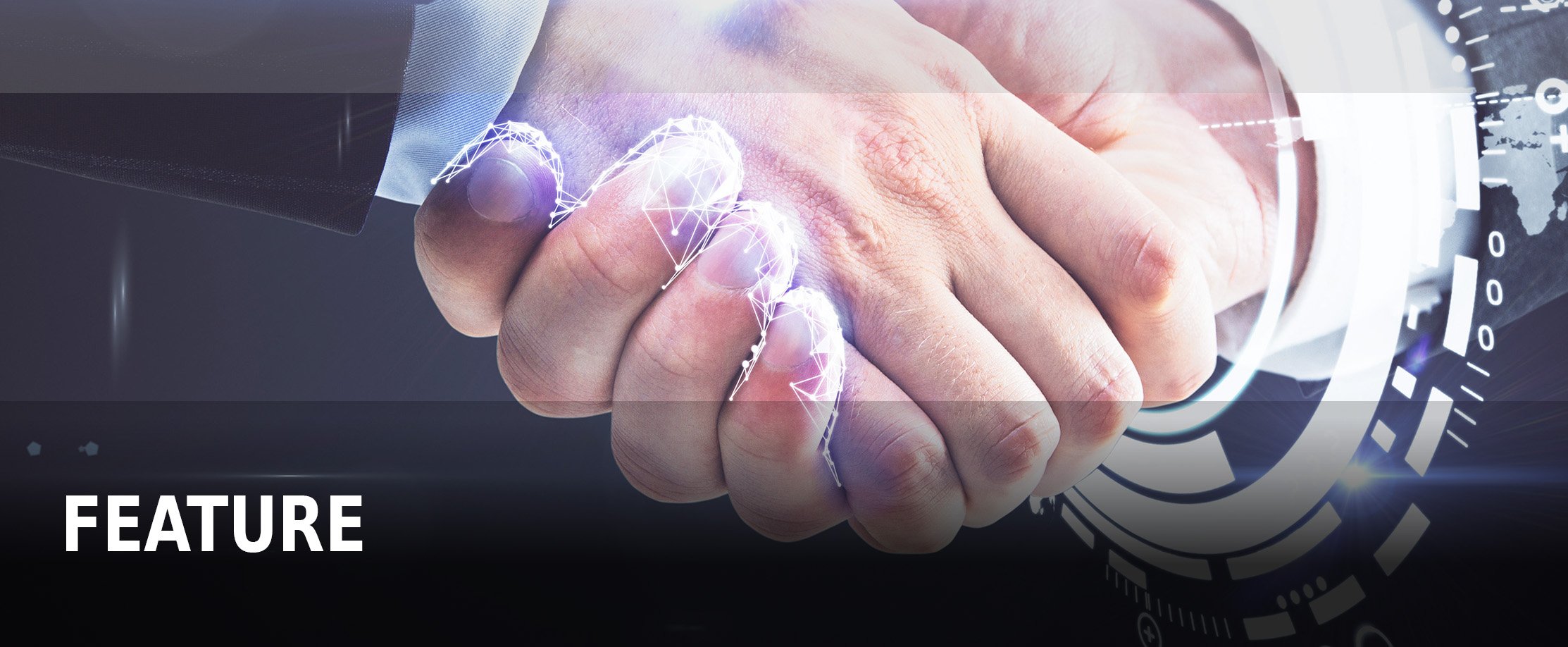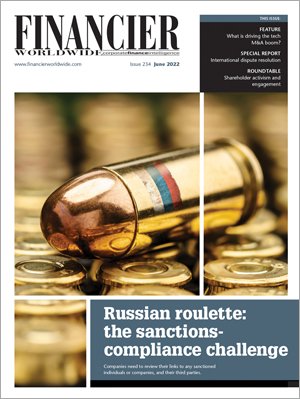What is driving the tech M&A boom?
June 2022 | FEATURE | MERGERS & ACQUISITIONS
Financier Worldwide Magazine
Since the second half of 2020, technology-driven M&A activity has boomed. Though the coronavirus (COVID-19) pandemic interrupted dealmaking across the board, tech M&A returned as companies positioned themselves to thrive in a digital economy.
The pandemic provided businesses with a glimpse into the future. Companies both inside and outside the sector are now increasing their reliance on digital tools, such as videoconferencing software and cloud computing. Furthermore, according to the EY 2022 CEO Survey, revenue growth, talent acquisition and technological innovation have also been key factors driving deal volume in the space.
Recent activity levels
According to GlobalData, 2020 ended with a 91.8 percent year-over-year increase in global tech M&A deals. Against that backdrop, in 2021, the total value of global M&A deals surpassed $5 trillion, with technology transactions the dominant driving force across multiple jurisdictions.
2021 was an exceptional year for tech M&A, with aggregate deal value soaring 71 percent higher than the previous year to top $1 trillion for the first time, and the sector accounting for 20 percent of total M&A transactions globally by value and 22 percent by volume, notes Dario de Martino, a partner at Allen & Overy LLP.
The total value of 2021’s tech transactions rose to $1.2 trillion, according to S&P Global Intelligence. The PE industry announced almost 1500 tech deals – 34 percent of all tech transactions, according to S&P Global’s 451 Research M&A KnowledgeBase. The total value of deals announced by PE firms in 2021 doubled the average of the past half-decade. Furthermore, the aggregate value of tech deals topped $250bn in every quarter of 2021.
Though it will be difficult for the industry to beat this impressive level of dealmaking going forward, there is a chance that activity will remain consistent throughout 2022. According to S&P Global’s 451 Research Tech M&A Outlook Survey, 41 percent of respondents predicted that 2021’s historic acquisition pace would continue in 2022, with 28 percent predicting a further increase on last year.
A varied range of acquirers were keen to complete deals in the tech space, from cash-rich buyout firms to special purpose acquisition companies (SPACs). “We are seeing deals at every level,” says Mr de Martino. “Big tech continues to invest at a growing pace. Non-tech companies are looking to speed up their own digital transformation, sometimes through full-blown transactions, sometimes through joint ventures or co-development deals, often through corporate venturing where they take small stakes in promising start-ups on a ‘try before you buy’ basis. Increasingly, private equity (PE) houses are moving into this space in force as well and are behaving like strategics.”
Numerous mega-deals have been announced in the tech space in recent years. In 2020, Xilinx paid $35bn for Advanced Micro Devices, and in 2021 Intuit bought Mailchimp for $12bn, while Square acquired Afterpay for $29bn. Dell spun off an 80.65 percent stake in VMware, Inc. for $60.8bn, MSP Recovery was acquired by Lionheart Acquisition Corporation for $44.3bn, and PayPal acquired Pinterest for $38.9bn.
Software leads the way
The cumulative value of software M&A deals soared to an all-time high in 2020 even as overall M&A activity decreased, according to Boston Consulting Group. That trend continued into the first three quarters of 2021, which saw the highest M&A spending on application software. Deal volume also surged to a new record high, fuelled by an astronomical increase in machine learning (ML) deals – there were 620 ML transactions in 2021, nearly quadruple the number just three years ago.
“The cumulative value of software M&A deals soared to an all-time high in 2020 even as overall M&A activity decreased. That trend continued into the first three quarters of 2021, which saw the highest M&A spending on application software.”
“Undoubtedly, software-related deals are the dominant driving force in this market, accounting for 43 percent of total tech deals in 2021 and worth a pretty staggering $490bn,” says Mr de Martino. “Established tech companies have upped their investment in this area as they move to cloud-based, subscription or enterprise-focused services. Collaboration and communication software has been particularly busy, partly fuelled by the pandemic. Non-tech companies often see software deals as the key to their own digital transformation.
“A really striking feature of the market recently has been heavy investment by PE houses, pension funds and sovereign wealth funds,” he continues. “The healthy profit margins and steady revenue streams promised by software as a service (SaaS) business models are proving attractive to them, as is the chance to build a portfolio of assets offering attractive synergies. So far, they have been prepared to pay rapidly rising multiples.”
Recent standout deals in the software space include Thoma Bravo’s $12.3bn acquisition of Proofpoint, the biggest PE cloud deal to date, and the take-private acquisition of cyber security giant McAfee by a consortium of PE, pension and sovereign wealth funds. Cloud-computing giant Salesforce also remained active in the sector, pursuing a series of recent deals including the $27.7bn acquisition of Slack.
The software industry is hugely valuable. In the US, it provides 15.8 million jobs to the economy across sector software, internet and cloud services, biotechnology, telecommunications, scientific research, semiconductor manufacturing, and aerospace research, and is growing faster than the country’s GDP, according to Software.org.
The industry added $1.9 trillion in total US value-added GDP in 2020, a 17.1 percent increase over two years. Software’s economic impact far outpaced the 2 percent growth of total US GDP over that same period. In 2020, the industry directly contributed $933bn to the US economy, a 15.1 percent increase compared to 2018. SaaS is tipped to be the fastest growing software segment moving forward. As cloud technology continues to mature, it will also contribute to transactions in the tech space.
Competition for software assets will keep valuations high. As such, it is important for acquirers to ensure they thoroughly vet their targets to lay the groundwork for a successful transaction. However, tech deals do present unique challenges from a due diligence, structuring and integration perspective, according to Mr de Martino. “Due diligence challenges are significant in this space,” he says. “For example, it is vital to understand the origins of a target’s software portfolio. Was it developed in-house, with a third party, was it licensed or acquired? If the history is not properly understood and documented, it can severely undermine the value of the software. Experienced buyers will often make it a signing or closing condition that software or IP issues revealed during due diligence are remedied,” he adds.
Furthermore, it is vital to conduct technical due diligence on the source code of the software being acquired to ensure it is high quality, scalable and not vulnerable to cyber attack. “Running penetration tests, with the target’s permission, can ensure the software is cyber secure,” says Mr de Martino. “Also, use of open source code is now widely accepted but carries risks. Careful checks are needed to make sure it has been properly licensed and used responsibly.”
Other buoyant segments
Another segment of the tech sector likely to drive dealmaking includes the commercial electric vehicle (EV) space, with SPACs in particular on the search for potential targets. Expected growth in the EV space will be further bolstered by the $7.5bn earmarked for EV charging technology in the US infrastructure bill.
The ‘buy now, pay later’ (BNPL) market has also been attracting interest. According to McKinsey’s Consumer Lending Pools data, FinTech organisations currently hold the majority of BNPL market share and have already captured about $8-10bn in annual consumer financing revenue. Though increased regulation is likely, so is a rise in transactions. Indeed, consolidation in the space is already underway, with Zip, Australia’s largest BNPL player, acquiring rival Sezzle in a $355m deal in February 2022.
The video game market has also seen huge growth in recent years. According to Newzoo, 2021’s global games market topped $180.3bn in revenue, with mobile games capturing $93.2bn, followed by console gaming at $50.4bn and PC games at $36.7bn. Some of the most high-profile recent tech deals have surfaced in the gaming industry. 2021 was a record year, with $85bn of value disclosed in over 1159 announced or closed deals, according to Drake Star Global Gaming Report 2021.
Microsoft’s acquisition of Activision Blizzard for $68.7bn and the sale of Zynga for $12.7bn to Take-Two Interactive may be the most notable deals of late. As the battle for subscription service content heats up, the video game industry will likely continue to see consolidation throughout the second half of 2022 and into 2023, particularly with respect to smaller companies and teams.
Additionally, though it is rather a nebulous concept, the so-called ‘metaverse’, which includes augmented reality (AR) and virtual reality (VR), is set to impact dealmaking as wider interest grows and funding flows in. In February 2022, for instance, Hiro Capital announced the biggest fund – Hiro Capital II, worth approximately $340m – to invest in seed and early rounds in categories like esports, creator platforms, the metaverse and more. In April, Epic Games, the video game publisher behind the popular PC and console game Fortnite, announced a $2bn funding round with plans to accelerate the company’s vision in the metaverse.
Impetus
Though there are encouraging signs that tech M&A will continue, there will be headwinds. “We entered 2022 strongly convinced that the momentum we saw last year was likely to continue and even intensify and, in the first few weeks of the year, we saw that to be the case,” says Mr de Martino. “Total M&A has, however, cooled since Russia’s invasion of Ukraine and no sector, not even one as vibrant as the tech sector, is insulated from such global shocks. There are also growing worries in the market about rising inflation, which could have an impact on deal financing as interest rates rise.”
Increased scrutiny of foreign direct investment (FDI) may also impact technology transactions. Regulatory control of FDI was tightening prior to the pandemic, but has accelerated over the last two years as technology becomes even more integral to economies. Going forward, technology deals which spark national security concerns are likely to be reviewed by regulators, irrespective of size.
That said, Mr de Martino is largely upbeat about the current prospects for tech M&A. “My sense is that investor appetite to find quality tech deals and get them over the line has not diminished, particularly where there is strong market impetus behind the transaction,” he says. “I fully expect to see activity continuing at a high level in the rest of 2022.”
As the COVID-19 era has demonstrated, companies are more reliant on technology solutions and are keen to pursue digital transformation. Increased reliance on cloud services and intensifying competition for talent, among other factors, have spurred recent dealmaking activity in the tech space and look set to play a role in the months ahead too. Gartner predicts that the global cloud services market, for example, could reach a value of $331.2bn in 2022. Though there are some headwinds, including increased FDI and antitrust scrutiny, the tech M&A boom could persist.
© Financier Worldwide
BY
Richard Summerfield


